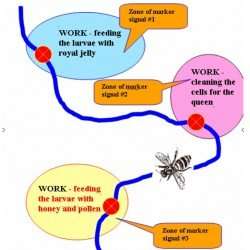Principles of using of vibro-acoustic markers and communicational signals in the process of bees' lives

How do the bees use this system of vibro-acoustical signals? Understanding now, how marker and communicational vibro-acoustic signals are arranged, and what, in principle, they serve, let's consider their application in the daily life of beehives.
Let's suppose that a bee of the age of about 5 days moves along the hive. Its own marker is set in the "position" "free," or it is not emitted in principle. The bee falls into the zone of action of vibro-acoustical marker signals of the group of bees No. 1, engaged in feeding the larvae with royal jelly. Her internal program verifies the possibility of joining this cluster. She analyzes the correspondence of work to her age. The answer is "no," this work cannot be performed yet. It's too early. Her glands are not matured yet. The bee continues her movement, and falls into the zone of action of vibro-acoustical marker of the group of bees No. 2. This marker determines the work of the bees on cleaning the cells for laying eggs by the queen. Her internal program analyzes the situation. The answer is "no." The bee has already left this age range. The bee continues her movement, and falls into the zone of action of vibro-acoustical markers of the group of bees No. 3. They are engaged in feeding the larvae with honey and pollen. The internal program of the bee analyzes the situation. The analysis shows that according to the age of the bee, this work is quite suitable for her. The bee joins the cluster, setting her own marker in accordance with the work being performed.
The view is somewhat simplistic. Most likely, there should be some marker, or communication, which may be tactile, that determines the need for such connection to the cluster of working bees.
It is possible that American scientists observed one of these signals during their studies. This was so-called worker piping. It is possible that this signal had a different purpose, because the bee roamed the honeycomb for a long time, and periodically released it—during an hour, or an hour and a half.
In all cases, the signal was seen as a short pulse, lasting from 0.5 to 1.5 seconds, filled with a frequency of 337 + -15 hertz. This data also confirms once again our idea that the bees communicate using very short impulse signals, which are difficult to process with the help of Fast Fourier Transform algorithms.
But this is not the end of the problems. There are some other technical features involved in understanding of the "language" of bees, but we do not have space and time to talk about them in this article.
Thus, we once again wish to state the following:
The vibro-acoustic signals of bees are a set of short pulses of certain frequency, or sum of frequencies, followed by certain intervals, and are markers of the type of activity of the bees, or communicational signals. These markers and communicational signals do not carry in themselves meaningful, as in our understanding, information, such as letters or words. They are only a means to attract attention, and markers of performed works or emotional states.
All these signals are used together with tactile signals and with the eyesight of bees.
Provided by CORDIS

















